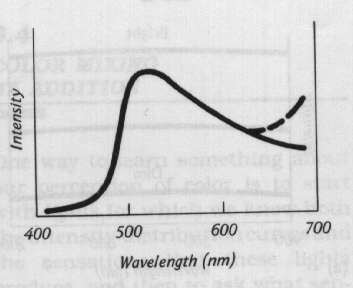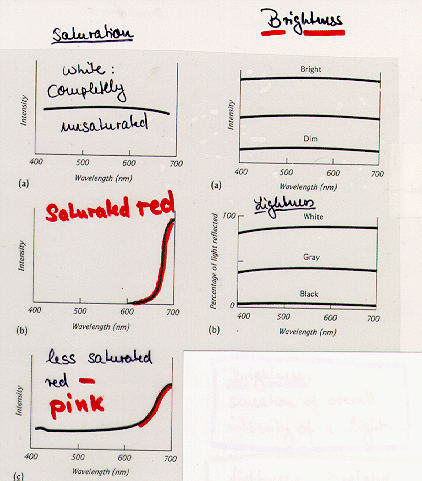
Color II



 Classification of Colors
Classification of Colors The eye detects 3 primary colors.
The color sensitive cells are the
cones.
 there are 3 distinct
types of cones. there are 3 distinct
types of cones.
They have a peak sensitivity at wavelengths of:

Monochromatic or
spectral
light consists of only one
wavelength.

Intensity distribution
Curve. Although in the above curve there is a predominance of green light, there is also a little bit of every other visible wavelength present. Thus, When on simultaneously plays two different notes on a piano, one usually hears the two separate notes. But when two different wavelengths of light shine on the same place on a screen, the eye does not separate the resulting light into two colors, rather ones sees some sort of mixture. We need to characterize the sensations of these mixtures.
Example: all yellows differ in hue from all blues, regardless of any other possible similarity. Hue is specified by the dominant wavelength in an intensity distribution curve. Thus, the greatest intensities in the above curve lie between 500 and 530 nm, so the hue of that light is some sort of green. Note: Artists use the terms chroma or intensity to express something similar to saturation.
White light , which consists of all wavelengths with no dominant one, is completely unsaturated. Other colors may be thought of as mixture of white light with a saturated color.
 Saturation:
We know how to change the brightness of a light (even a colored one), we need to adjust the intensity of the source. To change the lightness of a surface one must make it less reflecting. We often think of lightness as being related to the total amount of light reflected at all visible wavelengths, but we must be careful. We can change the amount of reflected light in two ways. One is to make the surface less reflecting, the other is to change the overall illumination, the incident light. But if you shine less light on a piece of white paper, it does not appear gray, it continues to look white. That is, the lightness of any surface is nearly independent of the overall illumination.
Try it! Surface reflections and saturation.
Colors may be arranged according to their hue, saturation, and lightness in a
The `trunk' of the tree consists of the completely unsaturated colors, it ranges from black at the bottom, through grays, to white at the top. That is the height is a measure of lightness. Our from the trunk, one finds different hues in different directions, the hue varies around the tree. Finally, as one moves away from the trunk in some direction, the color becomes more saturated This scheme is realized in the Munsell Color Tree, where colors are organized by hue, saturation and lightness.
|

Ch. Elster